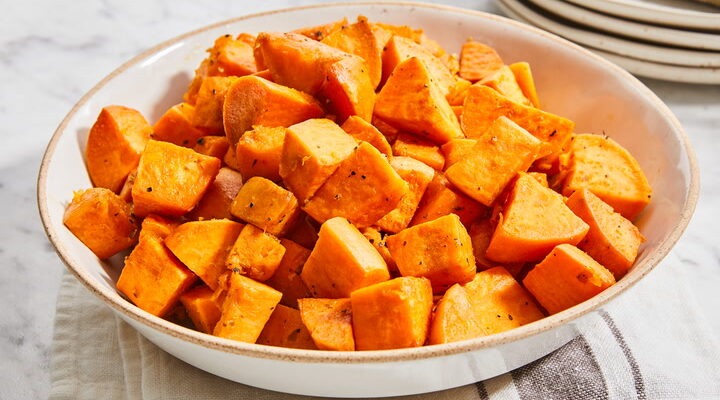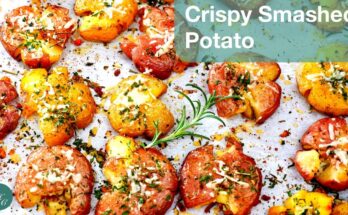Best Sweet Potato Recipe: Sweet potatoes are a timeless favorite. They’re sweet, hearty, and packed with flavor—and they’re a staple in kitchens around the world for a good reason. Whether you’re cooking for the holidays or just want a healthy side dish, sweet potatoes can easily fit the bill. They’re not only incredibly tasty but also offer a wide array of health benefits. High in fiber, beta-carotene, and vitamins A and C, sweet potatoes support good vision, digestion, and even immune health.
What’s more exciting is the sheer number of ways you can prepare them. From roasting and baking to mashing and air frying, sweet potatoes adapt to countless cooking styles. This guide will walk you through the best sweet potato recipe, designed to be simple, flavorful, and absolutely foolproof. So, if you’re ready to make a dish that’s delicious, nutritious, and bound to impress, stick with us.
Ingredients Needed
The beauty of this sweet potato recipe lies in its simplicity. You don’t need a laundry list of ingredients—just a few basics and some optional items if you’re feeling adventurous.
Basic Ingredients:
- 3 large sweet potatoes (peeled and cut into wedges)
- 2 tablespoons olive oil
- 1 teaspoon sea salt
- 1/2 teaspoon black pepper
- 1/2 teaspoon paprika
- 1/2 teaspoon garlic powder
Optional Add-ons:
- A sprinkle of cinnamon for a warm, sweet twist
- A dash of cayenne for heat
- Fresh herbs like rosemary or thyme for aroma
- A drizzle of maple syrup for added sweetness
Each ingredient serves a purpose. Olive oil ensures crispiness, while the spices add depth. You can customize the seasoning depending on whether you want your dish sweet or savory. That’s the charm—this recipe is a canvas, and you’re the artist.
Equipment You’ll Need
Before you start, make sure you have the right tools. Cooking sweet potatoes doesn’t require fancy kitchen gadgets, but having the essentials will make your job easier and the outcome better.
Essential Equipment:
- Cutting board and sharp knife: For prepping the potatoes
- Peeler: If you prefer your sweet potatoes peeled
- Large mixing bowl: To toss your potatoes in oil and seasoning
- Baking sheet: Ideally with a rim to avoid spillage
- Parchment paper or silicone baking mat: To prevent sticking and promote even roasting
- Oven mitts: Always safety first when dealing with hot trays!
Having these tools ready before you start can save time and prevent stress. You’ll be able to move smoothly from one step to the next without scrambling for what you need.
Preparation Tips
Great recipes start with great prep. This is especially true with sweet potatoes, where texture and flavor depend heavily on how well you prep your ingredients.
Choosing the Right Sweet Potatoes:
Look for firm, smooth sweet potatoes without blemishes or sprouts. While there are several varieties, the orange-fleshed ones (like Beauregard or Garnet) are ideal for baking due to their natural sweetness and moisture.
Cleaning and Peeling:
Even if you’re leaving the skin on, give them a good scrub under cold water to remove any dirt. If you prefer them peeled, use a sharp vegetable peeler and work in smooth, downward strokes. Avoid over-peeling to retain more nutrients.
Cutting Tips:
Consistency is key when cutting sweet potatoes. Try to make all wedges the same size to ensure they cook evenly. Too thin, and they might burn; too thick, and they could end up undercooked.
Step-by-Step Recipe Guide
Step 1 – Preheat the Oven
Preheat your oven to 425°F (220°C). This temperature is perfect for achieving that deliciously crisp exterior without drying out the inside. While your oven heats up, line your baking sheet with parchment paper for easy cleanup and non-stick results.
Preheating is often overlooked, but it’s crucial. Placing sweet potatoes in a cold oven leads to uneven cooking and soggy wedges. Always give your oven enough time to reach the right temperature.
Step 2 – Peel and Cut the Sweet Potatoes
Peel the sweet potatoes if desired, then cut them into uniform wedges or cubes. About 1/2-inch to 1-inch thick is ideal. Uniformity helps with even cooking, so don’t rush through this step.
If you’re prepping ahead, soak the cut sweet potatoes in cold water for 30 minutes. This helps draw out excess starch, leading to crispier results when baked. Just be sure to dry them thoroughly with a towel before seasoning.
Step 3 – Seasoning the Sweet Potatoes
Once your sweet potatoes are cut and dried, transfer them to a large mixing bowl. Add the olive oil, salt, pepper, paprika, and garlic powder. Use your hands or a spatula to toss everything together until the wedges are evenly coated. Don’t rush this part—each piece should glisten with oil and be well-seasoned.
This is where the magic starts. The paprika adds a smoky undertone, the garlic powder brings a savory depth, and the olive oil ensures the outside turns golden and slightly crisp. If you’re adding cinnamon or maple syrup for a sweeter touch, now is the time to mix those in as well. Want a spicy kick? A pinch of cayenne does wonders.
Seasoning is your chance to play around. Love bold flavors? Add cumin or chili powder. Prefer subtle notes? Stick with herbs like thyme or rosemary. The versatility here is endless, so don’t be afraid to experiment.
Step 4 – Baking to Perfection
Spread the seasoned sweet potatoes out on your lined baking sheet in a single layer. Avoid overcrowding—this is key to getting that beautiful roast. If they’re too close together, they’ll steam instead of bake, and you’ll miss out on the crispy edges.
Pop the tray into your preheated oven and bake for 25-30 minutes. Around the 15-minute mark, flip the sweet potatoes to ensure even cooking and browning on all sides. Keep an eye on them in the final minutes—ovens vary, and you want golden-brown edges with a soft, creamy center.
This is when your kitchen starts to smell amazing. The sweet, nutty aroma of roasting sweet potatoes mingles with spices, and it’s hard not to sneak a taste before they’re done.
When they’re ready, remove from the oven and let them cool for 5 minutes. This short wait lets the exterior crisp up just a bit more and makes them easier to handle.
Step 5 – Serving Suggestions
Now that your sweet potatoes are baked to perfection, it’s time to enjoy them. These roasted beauties can be served in so many delicious ways.
Here are some crowd-pleasing ideas:
- As a side dish: Pair with roasted chicken, grilled steak, or pan-seared salmon.
- As a snack: Serve with a dipping sauce like garlic aioli, chipotle mayo, or honey mustard.
- In a bowl: Add to a grain bowl with quinoa, avocado, black beans, and a squeeze of lime.
- For breakfast: Mix into a hash with eggs and spinach.
Want to get fancy? Top your roasted sweet potatoes with crumbled feta, toasted pecans, or a drizzle of balsamic glaze. Whether you’re keeping it classic or going gourmet, these sweet potatoes fit right in.
Flavor Variations
Sweet potatoes are like a blank canvas—they take on flavor beautifully, whether you’re going sweet or savory. Here are a few fun ways to mix things up:
Savory Twists:
- Garlic-Parmesan: Toss with minced garlic and grated parmesan during the last 5 minutes of baking.
- Spicy Cajun: Swap the regular seasoning with Cajun spice mix and a squeeze of lime.
- Herb-Roasted: Use a mix of rosemary, thyme, and oregano for a fresh, earthy flavor.
Sweet Versions:
- Maple-Cinnamon: Mix in 1 tablespoon maple syrup and 1/2 teaspoon cinnamon before baking.
- Honey Butter Glaze: Drizzle with melted butter and honey just before serving.
- Brown Sugar Delight: Toss with brown sugar, nutmeg, and cinnamon for a dessert-style side.
Feel free to blend your favorite flavors. Sweet potatoes welcome creativity, and there’s no wrong way to enjoy them.
Nutritional Value
Sweet potatoes aren’t just delicious—they’re also packed with nutrients that your body loves. Whether you’re trying to eat healthier, support digestion, or boost immunity, adding sweet potatoes to your diet is a smart move.
Rich in Vitamins and Minerals:
Sweet potatoes are a top source of vitamin A, particularly in the form of beta-carotene, which supports good vision, skin health, and immune function. A single medium-sized sweet potato can offer over 400% of your daily vitamin A needs!
They also provide:
- Vitamin C – essential for immune support and collagen production
- Vitamin B6 – aids brain development and function
- Potassium – helps manage blood pressure and fluid balance
- Manganese – supports bone health and metabolism
High in Fiber:
One of the unsung heroes in sweet potatoes is dietary fiber, which aids digestion and promotes a feeling of fullness. This makes them an excellent option for those looking to maintain or lose weight without sacrificing flavor.
Low on the Glycemic Index:
Compared to regular potatoes, sweet potatoes have a lower glycemic index, meaning they have a gentler effect on blood sugar levels. This makes them a better option for people managing diabetes or looking to avoid energy crashes.
Comparison with Regular Potatoes:
| Nutrient | Sweet Potato (100g) | White Potato (100g) |
|---|---|---|
| Calories | 86 | 77 |
| Fiber | 3g | 2.2g |
| Vitamin A | 283% RDI | 0% |
| Glycemic Index | ~44 | ~82 |
| Potassium | 337mg | 421mg |
While both are nutritious, sweet potatoes often come out ahead thanks to their vitamin A content and fiber. If you’re aiming for a balanced, health-conscious lifestyle, sweet potatoes are a fantastic choice.
Tips for Leftovers
Cooked too many sweet potatoes? No worries—leftovers can be just as tasty as the first round if stored and reheated properly. Here’s how to make sure you don’t waste a single bite.
Storing Leftovers:
- Let the sweet potatoes cool completely before storing.
- Use an airtight container to keep moisture and air out.
- Store in the fridge for up to 4-5 days.
If you want to keep them longer, sweet potatoes freeze surprisingly well. Place them in a single layer on a baking sheet to freeze individually before transferring to a freezer-safe bag. They can last in the freezer for up to 3 months.
Reheating Tips:
- Oven: Preheat to 375°F and bake for 10-15 minutes to re-crisp.
- Air fryer: Heat at 350°F for 5-7 minutes.
- Microwave: Use in 30-second intervals (but note: they may lose crispiness).
Want to give your leftovers a second life? Toss them into a salad, add to a burrito, or mash them for a quick breakfast hash. The possibilities are endless.
Common Mistakes to Avoid
Even the simplest recipes can go sideways with a few missteps. Here’s what to avoid when making your sweet potato dish:
1. Overcrowding the Pan
This is the number one culprit of soggy sweet potatoes. When they’re too close together, they steam instead of roast. Always use a large baking sheet and leave space between pieces.
2. Skipping the Oil
Oil isn’t just for taste—it’s key to getting that beautiful golden-brown crisp. Skimping on oil or using too little can leave your potatoes dry and undercooked.
3. Not Flipping Midway
Turning your sweet potatoes halfway through baking ensures even browning. If you leave them untouched, one side might burn while the other stays too soft.
4. Using Uneven Cuts
Size matters when it comes to cooking sweet potatoes. Uneven pieces cook at different rates, leaving you with a mix of burnt bits and raw chunks. Always aim for uniform cuts.
5. Over-seasoning
Too much seasoning can overpower the natural flavor of sweet potatoes. Start small—you can always add more after cooking if needed.
Avoiding these mistakes ensures that your dish turns out crispy, flavorful, and perfectly cooked every time.
FAQs about Sweet Potato Recipe
1. How long should sweet potatoes bake in the oven?
Bake sweet potato wedges at 425°F for 25–30 minutes, flipping halfway through for even crispiness.
2. Can I make this recipe in an air fryer?
Absolutely! Set your air fryer to 400°F and cook for 15–20 minutes, shaking the basket halfway through.
3. What’s the best way to store leftovers?
Cool completely, then store in an airtight container in the fridge for 4–5 days or freeze for up to 3 months.
4. Are sweet potatoes better peeled or unpeeled?
It depends on preference. Peeled gives a smoother texture, while unpeeled offers extra fiber and a rustic taste.
5. Can I use canned sweet potatoes for this recipe?
Not recommended for roasting—they’re already cooked and too soft. Fresh sweet potatoes give the best texture and flavor.
Conclusion
Sweet potatoes are a kitchen superstar—nutritious, versatile, and downright delicious. With just a few simple ingredients and the right steps, you can create a dish that’s comforting, flavorful, and sure to please everyone at the table. From prepping and seasoning to roasting and serving, this recipe makes it easy to get perfect results every time.
Whether you enjoy them as a side, snack, or main course, sweet potatoes offer the kind of flexibility and flavor that makes them a go-to ingredient for any home cook. So grab a tray, preheat that oven, and get ready to fall in love with the best sweet potato recipe you’ll ever try.



